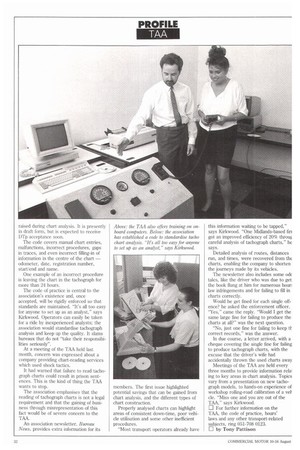raised during chart analysis. It is presently in draft form, but is expected to receive DTp acceptance soon.
Page 34

If you've noticed an error in this article please click here to report it so we can fix it.
The code covers manual chart entries, malfunctions, incorrect procedures, gaps in traces, and even incorrect filling-in of information in the centre of the chart — odometer, date, registration number, start/end and name.
One example of an incorrect procedure is leaving the chart in the tachograph for more than 24 hours.
The code of practice is central to the association's existence and, once accepted, will be rigidly enforced so that standards are maintained. "It's all too easy for anyone to set up as an analyst," says Kirkwood. Operators can easily be taken for a ride by inexperienced analysts; the association would standardise tachograph analysis and keep up the quality. It slams bureaux that do not "take their responsibilities seriously".
At a meeting of the TAA held last month, concern was expressed about a company providing chart-reading services which used shock tactics.
It had warned that failure to read tachograph charts could result in prison sentences. This is the kind of thing the TAA wants to stop.
The association emphasises that the reading of tachograph charts is not a legal requirement and that the gaining of business through misrepresentation of this fact would be of severe concern to the TAA.
An association newsletter, Bureau News, provides extra information for its
members. The first issue highlighted potential savings that can be gained from chart analysis, and the different types of chart construction.
Properly analysed charts can highlight areas of consistent down-time, poor vehicle utilisation and some other inefficient procedures.
"Most transport operators already have this information waiting to be tapped," says Kirkwood. "One Midlands-based fin got an improved efficiency of 20% throng careful analysis of tachograph charts," he says.
Detailed analysis of routes, distances run, and times, were recovered from thE charts, enabling the company to shorten the journeys made by its vehicles.
The newsletter also includes some odc tales, like the driver who was due to get the book flung at him for numerous hour: law infringements and for failing to fill in charts correctly.
Would he get lined for each single offence? he asked the enforcement officer. "Yes," came the reply. "Would I get the same large fine for failing to produce the charts at all?" was the next question.
"No, just one fine for failing to keep tt correct records," was the answer.
In due course, a letter arrived, with a cheque covering the single fine for failing to produce tachograph charts, with the excuse that the driver's wife had accidentally thrown the used charts away Meetings of the TAA are held every three months to provide information relai ing to key areas in chart analysis. Topics vary from a presentation on new tachograph models, to hands-on experience of workshop rolling-road calibration of a vet de. "Miss one and you are out of the TAA," says Kirkwood. 1=1 For further information on the TAA, the code of practice, hours' laws and any other transport-related subjects, ring 051-708 0123.
111 by Tony Pattison


































































































































